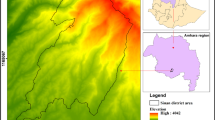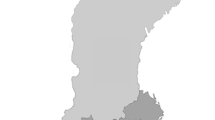Abstract
Urban forests are becoming more critical as climate-induced disasters and disturbances tend to increase and affect cities. Forest managers are the responsible technical people on the ground to implement forestry-related climate policies. There is limited knowledge on the capacities of forest managers related to climate change issues. In this study, we surveyed 69 forest district managers of 28 provinces and compared their responses with actual data to understand their perceptions of urban green areas and climate change issues. We used a set of digital maps of the 1990–2015 period to identify land cover changes. To calculate the urban forest cover in the city centers, we used the city limit delineation shapefiles produced by the EU Copernicus program. We also employed the land consumption rate/population growth rate metric and a principle component analysis (PCA) to identify and discuss the provinces’ land and forest cover changes. The results showed that forest district managers were aware of the general condition of the forests in their provinces. Still, there was a considerable inconsistency between actual land use changes (i.e., deforestation) and their responses. The study also revealed that the forest managers were aware of the increasing influence of climate change issues but were not knowledgeable enough to establish the connection between their tasks and climate change. We concluded that the national forestry policy should prioritize the urban-forest interaction and develop the capacities of district forest managers to improve the efficiency of climate policies on a regional scale.








Similar content being viewed by others
Data availability
We used three data sources in this study. The survey performed toward the forest managers has been done online, and the results are available from the corresponding author on reasonable request.
We used Copernicus programs Urban Atlas database to delineate urban centers. The shapefiles are open to the public and available online.
The land cover datasets generated during and/or analyzed during the current study are available from the corresponding author on reasonable request.
References
Aamodt, G., Nordh, H., & Nordbø, E. C. A. (2023). Relationships between socio-demographic / socio-economic characteristics and neighborhood green space in four Nordic municipalities – Results from NORDGREEN. Urban Forestry & Urban Greening, 82, 127894. https://doi.org/10.1016/J.UFUG.2023.127894
Alphan, H., Karamanli, E., Derse, M. A., & Uslu, C. (2022). Analyzing pattern features of urban/rural residential land use change: The case of the southern coast of Turkey. Land Use Policy, 122, 106348. https://doi.org/10.1016/J.LANDUSEPOL.2022.106348
Alturk, B., Kurc, H. C., Konukcu, F., & Kocaman, I. (2022). Multi-criteria land use suitability analysis for the spatial distribution of cattle farming under land use change modeling scenarios in Thrace Region, Turkey. Computers and Electronics in Agriculture, 198, 107063. https://doi.org/10.1016/J.COMPAG.2022.107063
Arnfield, A. J. (2003). Two decades of urban climate research: A review of turbulence, exchanges of energy and water, and the urban heat island. International Journal of Climatology, 23(1). https://doi.org/10.1002/joc.859
Capon, S. J., Chambers, L. E., Mac Nally, R., Naiman, R. J., Davies, P., Marshall, N., Pittock, J., Reid, M., Capon, T., Douglas, M., Catford, J., Baldwin, D. S., Stewardson, M., Roberts, J., Parsons, M., & Williams, S. E. (2013). Riparian ecosystems in the 21st century: Hotspots for climate change Adaptation? Ecosystems, 16(3). https://doi.org/10.1007/s10021-013-9656-1
Chang, Y., Xiao, J., Li, X., Frolking, S., Zhou, D., Schneider, A., Weng, Q., Yu, P., Wang, X., Li, X., Liu, S., & Wu, Y. (2021). Exploring diurnal cycles of surface urban heat island intensity in Boston with land surface temperature data derived from GOES-R geostationary satellites. Science of the Total Environment, 763. https://doi.org/10.1016/j.scitotenv.2020.144224
Day, S. D., Ries, P., Bassett, C. G., Wiseman, P. E., & O’Herrin, K. (2022). Support for a new credential in urban forestry: Results from a survey of urban forest professionals. Urban Forestry & Urban Greening, 73, 127588. https://doi.org/10.1016/J.UFUG.2022.127588
Duncker, P. S., Raulund-Rasmussen, K., Gundersen, P., Katzensteiner, K., De Jong, J., Ravn, H. P., Smith, M., Eckmüllner, O., & Spiecker, H. (2012). How forest management affects ecosystem services, including timber production and economic return: Synergies and trade-offs. Ecology and Society, 17(4). https://doi.org/10.5751/ES-05066-170450
FAO. (2020). Global Forest Resources Assessment 2020. In Global Forest Resources Assessment 2020. FAO.https://doi.org/10.4060/CA9825EN
Gençay, G., & Mercimek, A. (2019). Public consciousness and ınfluence of law on forest crimes: Insights from Kastamonu, Turkey. Forest Policy and Economics, 106, 101978. https://doi.org/10.1016/J.FORPOL.2019.101978
Gorzelany, J., Noszczyk, T., Kukulska-Kozieł, A., & Hernik, J. (2023). Urban green spaces management during the COVID-19 pandemic: Experiences from Kraków, Poland. Land Degradation & Development, 34(2), 423–440. https://doi.org/10.1002/LDR.4469
Hu, J., Wang, Y., Taubenböck, H., & Zhu, X. X. (2021). Land consumption in cities: A comparative study across the globe. Cities, 113. https://doi.org/10.1016/j.cities.2021.103163
Lawler, J. J., Spencer, B., Olden, J. D., Kim, S. H., Lowe, C., Bolton, S., Beamon, B. M., Thompson, L., & Voss, J. G. (2013). Mitigation and adaptation strategies to reduce climate vulnerabilities and maintain ecosystem services. In Climate vulnerability: Understanding and addressing threats to essential resources, 4. https://doi.org/10.1016/B978-0-12-384703-4.00436-6
Li, H., Zhou, Y., Li, X., Meng, L., Wang, X., Wu, S., & Sodoudi, S. (2018). A new method to quantify surface urban heat island intensity. Science of the Total Environment, 624. https://doi.org/10.1016/j.scitotenv.2017.11.360
Li, K., Chen, Y., Wang, M., & Gong, A. (2019). Spatial-temporal variations of surface urban heat island intensity induced by different definitions of rural extents in China. Science of the Total Environment, 669. https://doi.org/10.1016/j.scitotenv.2019.03.100
Liu, W., Li, H., Xu, H., Zhang, X., & Xie, Y. (2023). Spatiotemporal distribution and driving factors of regional green spaces during rapid urbanization in Nanjing metropolitan area, China. Ecological Indicators, 148, 110058. https://doi.org/10.1016/J.ECOLIND.2023.110058
Man, C. D., Lyons, K. C., Nelson, J. D., & Bull, G. Q. (2013). Potential of alternate forest management practices to sequester and store carbon in two forest estates in British Columbia, Canada. Forest Ecology and Management, 305, 239–247. https://doi.org/10.1016/j.foreco.2013.05.059
Nicolau, A. P., Herndon, K., Flores-Anderson, A., & Griffin, R. (2019). A spatial pattern analysis of forest loss in the Madre de Dios region, Peru. Environmental Research Letters, 14(12). https://doi.org/10.1088/1748-9326/ab57c3
NIR Turkiye. (2022). National GHG ınventory report of Türkiye. 576 pages. Retrieved November 19, 2022, from https://unfccc.int/documents/461926
Oke, T. R. (1988). The urban energy balance. Progress in Physical Geography, 12(4). https://doi.org/10.1177/030913338801200401
Pazúr, R., Feranec, J., Štych, P., Kopecká, M., & Holman, L. (2017). Changes of urbanised landscape identified and assessed by the Urban Atlas data: Case study of Prague and Bratislava. Land Use Policy, 61, 135–146. https://doi.org/10.1016/J.LANDUSEPOL.2016.11.022
Persson, J., Blennow, K., Gonçalves, L., Borys, A., Dutca, I., Hynynen, J., Janeczko, E., Lyubenova, M., Martel, S., Merganic, J., Merganičová, K., Peltoniemi, M., Petr, M., Reboredo, F. H., Vacchiano, G., & Reyer, C. P. O. (2020). No polarization-expected values of climate change impacts among European forest professionals and scientists. Sustainability (Switzerland), 12(7). https://doi.org/10.3390/su12072659
Seavy, N. E., Gardali, T., Golet, G. H., Griggs, F. T., Howell, C. A., Kelsey, R., Small, S. L., Viers, J. H., & Weigand, J. F. (2009). Why climate change makes riparian restoration more important than ever: Recommendations for practice and research. Ecological Restoration, 27(3). https://doi.org/10.3368/er.27.3.330
Soucy, A., De Urioste-Stone, S., Rahimzadeh-Bajgiran, P., Weiskittel, A., & McGreavy, B. (2020). Understanding characteristics of forest professionals and small woodlot owners for communicating climate change adaptation. Trees, Forests and People, 2. https://doi.org/10.1016/j.tfp.2020.100036
Sousa-Silva, R., Verbist, B., Lomba, Â., Valent, P., Suškevičs, M., Picard, O., Hoogstra-Klein, M. A., Cosofret, V. C., Bouriaud, L., Ponette, Q., Verheyen, K., & Muys, B. (2018). Adapting forest management to climate change in Europe: Linking perceptions to adaptive responses. Forest Policy and Economics, 90. https://doi.org/10.1016/j.forpol.2018.01.004
Stone, B. (2007). Urban and rural temperature trends in proximity to large US cities: 1951–2000. International Journal of Climatology, 27(13). https://doi.org/10.1002/joc.1555
Viscarra, F. E., & Zutta, B. R. (2022). Models of deforestation for setting reference levels in the context of REDD: A case study in the Peruvian Amazon. Environmental Science & Policy, 136, 198–206. https://doi.org/10.1016/J.ENVSCI.2022.05.015
Wang, J., Zhang, Y., Zhang, X., Song, M., & Ye, J. (2023). The spatio-temporal trends of urban green space and its interactions with urban growth: Evidence from the Yangtze River Delta region, China. Land Use Policy, 128, 106598. https://doi.org/10.1016/J.LANDUSEPOL.2023.106598
Williamson, T. B., Johnston, M. H., Nelson, H. W., & Edwards, J. E. (2019). Adapting to climate change in canadian forest management: Past, present and future. Forestry Chronicle, 95(2). https://doi.org/10.5558/tfc2019-015
Wolff, M., & Haase, D. (2019). Mediating sustainability and liveability-turning points of green space supply in European cities. Frontiers in Environmental Science, 7(May). https://doi.org/10.3389/fenvs.2019.00061
Xu, F., Yan, J., Heremans, S., & Somers, B. (2022). Pan-European urban green space dynamics: A view from space between 1990 and 2015. Landscape and Urban Planning, 226, 104477. https://doi.org/10.1016/J.LANDURBPLAN.2022.104477
Author information
Authors and Affiliations
Contributions
Erda Çeler has done the survey preparation, statistical analysis, and leading authoring. Yusuf Serengil performed the geographical information systems work and checked the analysis results to support Erda Çeler. Ufuk Özkan contributed to the interpretation of the results and editing.
Corresponding author
Ethics declarations
Competing interests
The authors declare no competing interests.
Additional information
Publisher's Note
Springer Nature remains neutral with regard to jurisdictional claims in published maps and institutional affiliations.
Rights and permissions
Springer Nature or its licensor (e.g. a society or other partner) holds exclusive rights to this article under a publishing agreement with the author(s) or other rightsholder(s); author self-archiving of the accepted manuscript version of this article is solely governed by the terms of such publishing agreement and applicable law.
About this article
Cite this article
Çeler, E., Serengil, Y. & Özkan, U. A comparative assessment of forest/green cover and the awareness of forestry district managers. Environ Monit Assess 195, 520 (2023). https://doi.org/10.1007/s10661-023-11146-4
Received:
Accepted:
Published:
DOI: https://doi.org/10.1007/s10661-023-11146-4




